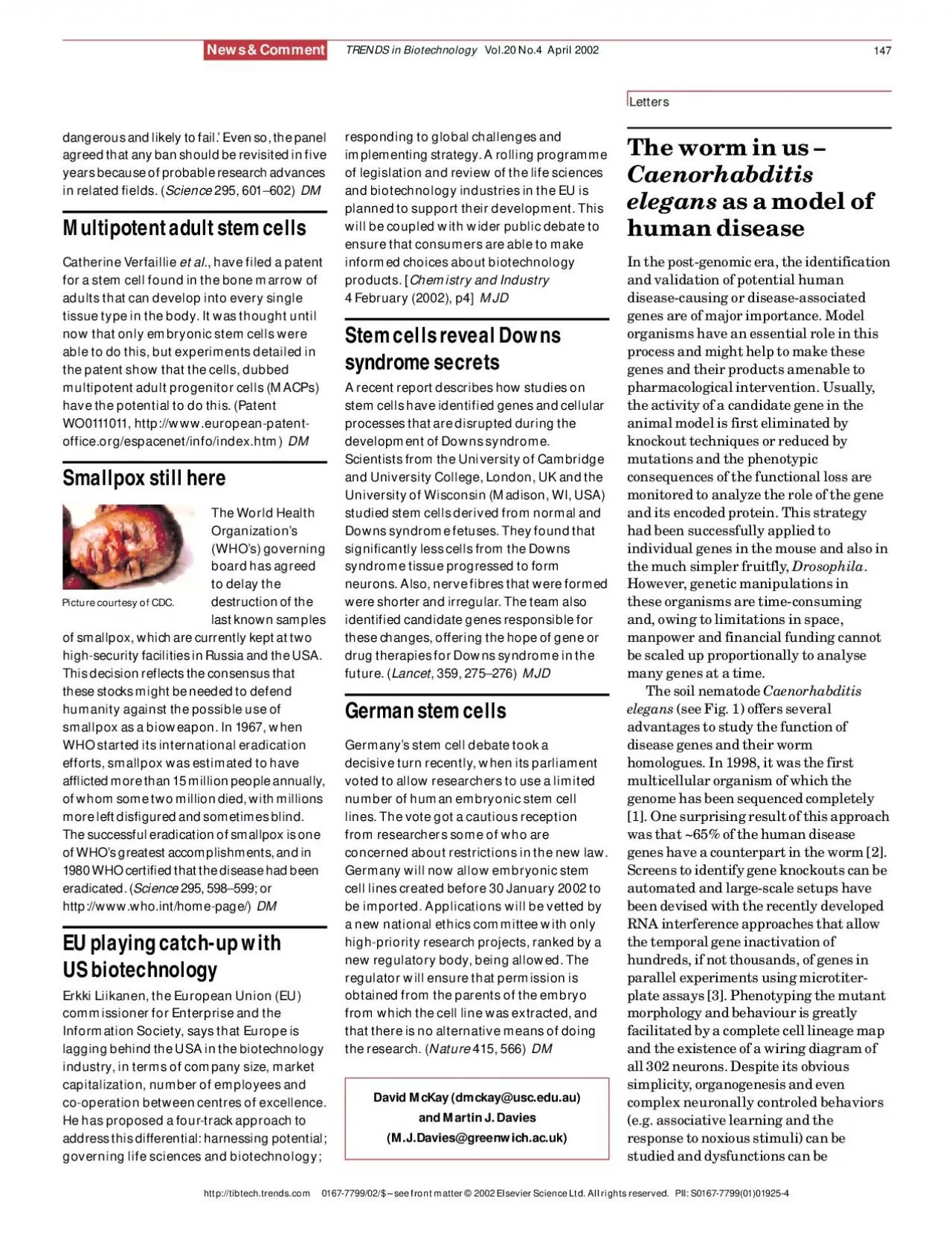

Catherine Verfaillie for a stem cell found in the bone marrow oftissue type in the body It was thought untilable to do this but experiments detailed inmultipotent adult progenitor cells MACPshave ID: 938619
Download Pdf The PPT/PDF document "dangerous and likely to fail Even so the..." is the property of its rightful owner. Permission is granted to download and print the materials on this web site for personal, non-commercial use only, and to display it on your personal computer provided you do not modify the materials and that you retain all copyright notices contained in the materials. By downloading content from our website, you accept the terms of this agreement.
dangerous and likely to fail. Even so, the panelagreed that any ban should be revisited in fiveyears because of probable research advancesScience 295, 601602) Catherine Verfaillie for a stem cell found in the bone marrow oftissue type in the body. It was thought untilable to do this, but experiments detailed inmultipotent adult progenitor cells (MACPs)have the potential to do this. (Patent The World HealthOrganizations(WHOs) governingof smallpox, which are currently kept at twohigh-security facilities in Russia and the USA.these stocks might be needed to humanity against the possible use ofsmallpox as a bioweapon. In 1967, whenWHO started its international eradicationefforts, smallpox was estimated to haveafflicted more than 15million people annually,more left disfigured and sometimes blind.The successful eradication of smallpox is one USbiotechnologyErkki Liikanen, the European Union (EU)Information Society, says that Europe islagging behind the USA in the biotechnologyindustry, in terms of company size, marketHe has proposed a four-track approach toaddress this differential: harnessing potential;governing life sciences and biotechnology;responding to global challenges andimplementing strategy. A rolling programmeand biotechnology industries in the EU is A recent report describes how studies onScientists from the University of Cambridgeand University College, London, UK and theUniversity of Wisconsin (Madison, WI, USA)studied stem cells derived from normal andwere shorter and irregular. The team alsothese changes, offering the hope of gene or Germanys stem cell debate took a decisive turn recently, when its parliamentvoted to allow researchers to use a limitedlines. The vote got a cautious receptionfrom researchers some of who areconcerned about restrictions in the new law.Germany will now allow embryonic stemcell lines created before 30 January 2002 tobe imported. Applications will be vetted bya new national ethics committee with onlyhigh-priority research projects, ranked by anew regulatory body, being allowed. Thefrom which the cell line was extracted, andthat there is no alternative means of doingthe research. ( News&CommentLetters The worm in us Caenorhabditisas a model ofhuman diseaseIn the post-genomic era, the identification Picture courtesy of CDC. TRENDSin Biotechnology Vol.20 No.4 April 2002http://tibtech.trends.com News&CommentNews&CommentNews&CommentNews&CommentCommentamenable to molecular, genetic andC.elegansencoded proteins. Most importantly, theC.elegans
C.elegansprobably, also in humans. However, the, theRecently, considerable effort has beendisorders, such as Alzheimers,Huntingtons and Parkinsons diseases.early onset familial Alzheimers disease,C.eleganselegansDespite this obvious phenotypicdiscrepancy between invertebrate andmammalian dysfunction, a remarkabledegree of functional conservation wasdemonstrated in several studies byrescuing the worm defects throughtransgenic expression of the respectivehuman wild-type genes [5,7]. Such anultimate proof of functional conservationcan probably be devised for manyhomologous genes found in both humanand worm genome. Transgenic C.elegansmicroinjection of DNAhosting the gene ofthe transgenic progeny. If the humanmuscular dystrophy [8]. Until recently, itclose relative, utrophin. However, worms, wormsof C. eleganscan now be exploited toidentify modifier genes that might definethe cellular mechanisms these factors areinvolved in. Look out for more examples offunctional conservation, perhaps even ofentire pathways, in the near future!In addition to the ease of geneticmanipulations, this tiny nematode hasone major advantage that might developit into a superb tool for the biotechin microtiter plates in both 96- andmicrotiter plates in both 96- anddevelopment using humanized worms(e.g., C. elegansknockout strainsexpressing the homologous humandisease mutant) on a large scale istherefore feasible [10]. And, perhaps theAlzheimers disease or DuchenneMuscular Dystrophy will, one day, be theRalf BaumeisterNeurogenetics, Schillerstr. 44, D-80336 Munich, Germany.*e-mail: ralf.baumeister@pbm.med.uni-muenchen.deEleGene AG, Am Klopferspitz 19, D-82152Martinsried, GermanyReferences1The aplatform for investigating biology.282,201220182Sonnhammer, E.L. and Durbin, R. (1997)Analysis of protein domain families inCaenorhabditis elegans.Genomics3Bargmann, C.I. (2001) High-throughput reverse4Wittenburg, N. and Baumeister, R. (1999)an approach to the study of nociception.Proc.Natl. Acad. Sci. U. S. A.5Wittenburg, N. 6Hengartner, M.O. (2001) Apoptosis: corrallingthe corpses. 7Levitan, D. (1996) Assessment of normaland mutant human presenilin function inCaenorhabditis elegans.Proc. Natl. Acad. Sci.U.S. A.8Bessou, C. 2,61729Ferree, T.C. and Lockery, S.R. (1999)C. elegans.J. Comput. Neurosci.6,26327710Link, E.J. Fig. 1.Until recently, the consequences of mutationsCaenorhabditis elegansLife staining with green fluorescent protein and DsRed(leftinset) now facilitate the automated analysis oflarge numbers of worms